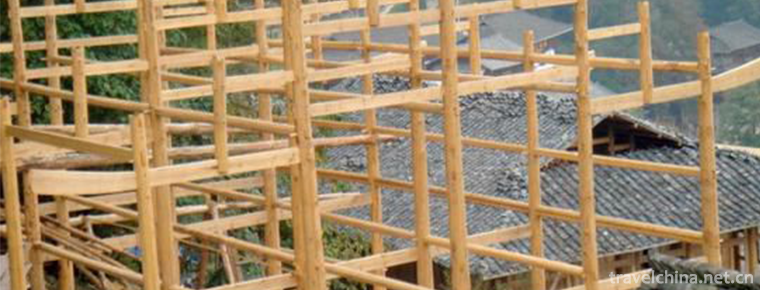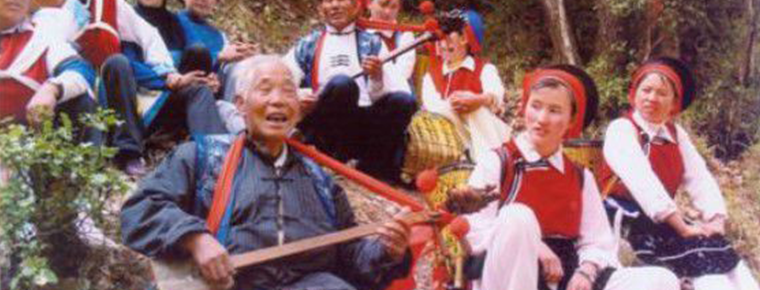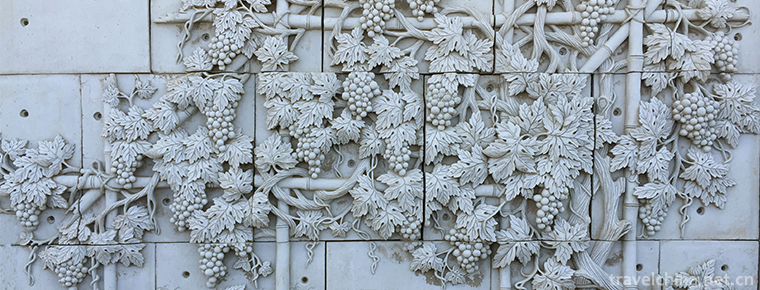2019-05-05

- By ChinaWiki.net
- Chinese Edition
- 2019-06-05
Construction Techniques of Miaozhai Diaojiao Building
Miaozhai Diaojiao Building is a traditional handicraft in Leishan County, Guizhou Province. It is one of the national intangible cultural heritages.
Miaozhai hanging-feet building is evolved from the form of "nest dwelling". It is built with bamboo and wood. The lower part of the building is hollow. It is called "semi-dry fence" wooden structure building. The main type of building is minority inhabited areas.
On May 20, 2006, the construction techniques of the Miaozhai Diaojiao Building were approved by the State Council of the People's Republic of China and listed in the first batch of national intangible cultural heritage list, the heritage number is_-31.
historical origin
Miao ethnic group evolved from the Miao Man ethnic group living in the middle and lower reaches of the Yangtze River in the ancient times of China, and the Three Miao Age has been formed. Miao people migrated to southeastern Guizhou and later lived in Xijiang. All kinds of ancient Miao culture, including residential building technology, were brought here, and inherited and developed here.
There is a saying in Chinese history books that "the northern people live in caves and the southern people live in nests". In the Spring and Autumn Period and the Warring States Period, Qu Yuan, a poet of the State of Chu, wrote in Nine Songs, Dongjun: "I will be in the East, and I will follow my threshold to Fusang." The "sill" refers to the "dry fence" building. Quyuan's poems describe the houses of Miao and other ancestors in Chu area. According to historical records, the Miao people live in caves and grow grass to shelter themselves from wind and rain. From the moment it happened, we built a wooden house with rock walls and towered towers. It can be seen that Miao's hanging-feet building has a long history.
The construction technique of Miaozhai hanging-feet building is the embodiment of the ancient architectural technology inherited by its ancestors, which is gradually perfected in adapting to the new environment of mountain areas.
Process characteristics
environmental protection
Miaozhai Diaojiao Building has the advantages of simplicity, stability and moisture-proof, and can save arable land and building materials.
Qianhu Miao Village in Xijiang has different shapes of suspension tower, which is full of vitality in form and is a building structure of the unity of man and nature. After the Miao family moved to the local area, in order to leave more flat land for cultivation, and to adapt to the local natural conditions, so that the nation can thrive, most of the Miao family chose to build their dwellings on steep slopes of 30 -70. On the basis of inheriting the traditional dry-fence buildings, they created a bucket-style wooden structure suspension tower.
Structure
The frame of the suspension tower in Miaozhai is joined by tenons and mortises. There are thousands of mortises on the pillars, beams and beams of a house. Carpenters (mostly Chinese illiterates before the 1960s) never use drawings. With ink buckets, axes, chisels, saws and various schemes of bamboo-making on their chest, they can connect pillars, beams and beams, making a three-storey wooden building stand tall on steep slopes and steep ridges, which shows the Miao people's residential builders. Technological level.
Miaozhai hanging-feet building uses high-level mechanical building principles and common geometric figures. From the macro point of view, the shape of the hanging-feet building is a combination of rectangle and triangle, a stable and solemn ordinary geometric figure, giving people a sense of both elegant and elegant beauty and upright and vigorous beauty. The columns, loquats, beams and purlins all intersect vertically, forming a network system that is vertically perpendicular to each other in three-dimensional space, thus laying the foundation of the rectangular structure, and then extending and combining one by one to form the whole roof. Because of the need of drainage, the roof must be two-sided or multi-sided, so that the most stable triangular structure can be determined. Horizontally, the upper, middle and lower parts of the house are composed of a triangle and two cuboids. Such a construction, in addition to ensuring structural stability, also appears dignified and stable in the sense of art.
The foot building shows the artistic effect of harmony and unity and complement each other in the contrast between the real and the virtual. The wooden structure with delicate cross-section is extremely light and agile. The suspension foot building on the half side of Miao residence highlights the effect of "light". "Suspended fictional house", standing overhead, real and virtual, strong contrast.
Style
The unique style of the hanging-feet building makes it famous overseas. Generally speaking, the hanging-feet half building is built on slopes with large inclination, the latter half is landed on rocks, the former half is supported by wooden columns, and the building is built with local lumber. Through the rational use of slope surface, the upper and lower two-stage roof foundation, the lower vertical longer columns, the upper vertical shorter columns, so that the front half of the floor and the rear half of the ground parallel, thus forming a half-side building with different styles. The suspended foot building has two forms: semi-suspended foot and full suspended foot. The roof foundation is mostly made of large surface stone. The hanging-feet building is a dry-fence building with wooden frame and bucket-piercing beam on the top of Xieshan Mountain. The roof is covered with green tiles or Chinese fir bark. After the exploration and perfection of the Miao people in past dynasties, together with the continuous processing and decoration, the hanging-feet building is more simple and practical. The most valuable thing is that, on the basis of paying attention to practicality, the hanging-feet building is also exquisite in artistic skills. Its beautiful and generous architecture is deeply loved by people and adds gorgeous colors to the Miao village.
Inheritance and protection
Inheritance value
The construction techniques of the Miaozhai hanging-feet building, together with the related construction customs, form the architectural culture of the Miao hanging-feet building, which is of great value to the study of the process of social civilization and architectural science of the Miao people in Xijiang.
The construction technique of Miaozhai hanging-feet building is the gradual perfection of the ancient dry-fence construction technology brought about by the Miao ancestors'migration from the middle and lower reaches of the Yangtze River basin to adapt to the new environment in mountainous areas. It is also the carrier of Miao architectural culture. In residential buildings, hanging-feet wooden building not only has a long history and unique status, but also is the foundation of Miao ethnic minorities to settle down, multiply their descendants and continue their national history. The thousands of Miao villages in Xijiang are large-scale and magnificent. They are a complex of natural environment, nationality, history, living habits and religious beliefs. They have certain historical value and academic research value for the study of Miao's history and culture. They also have certain practical value for the Miao people.
Inheritance status
With the acceleration of rural urbanization and the continuous improvement of infrastructure construction, the physical protection and the continuation of architectural culture of thousands of Miaozhai hanging-feet building in Xijiang are facing extremely severe challenges.
1. Because the hanging-feet building construction technology is inherited by teachers, human factors play a decisive role, and the inheritance mode is quite fragile. In the thousands of Miao villages in Xijiang, there are few carpenters, some of whom are old.
2. Geological collapse, landslides, residential buildings built on steep slopes, coupled with the age-old buildings, dryness and flammability, fire hazards, as well as production and living fires, are all risk factors leading to the destruction of building entities.
The impact of foreign culture and the change of ideas make some young people gradually change their sense of national recognition and identity. Many young people are reluctant to live in old wooden houses. They think that living in wooden houses is backward and backward. They prefer to live in tall and tidy buildings and are reluctant to learn the skills of such ancient and simple buildings.
4. The intervention of new architecture has caused serious imbalance in the architectural style and cultural connotation of thousands of Miao villages in Xijiang, especially in the construction of traffic and office buildings and residential buildings, which has brought great pressure to the protection of the architectural art of the suspended foot buildings in thousands of Miao villages in Xijiang.
Inheriting characters
Tang Bingwu is the contemporary provincial inheritor of the construction techniques of Miaozhai hanging-feet building. In addition, there are more than 40 Miao carpenters who can play a unique role. They are all from their elders or elder brothers in their own homes or villages, forming a pattern of succession from generation to generation.
protective measures
The government of southeastern Guizhou has mandatory protection for the traditional villages in Xijiang in its planning. It stipulates that the main body of newly constructed buildings must maintain the style and form of wooden structure and tile roof, with a ceiling of 11.6 meters.
In order to strengthen the protection of the whole Xijiang scenic area, including the hanging-feet building, the Leishan County People's Government has organized and completed the "Protective and Controlling Planning for the Thousand Miao Villages of Xijiang River in Leishan County", "Historical and Cultural Protection Planning for Xijiang River in Leishan County", "General Planning for Miao Township Tourism Area in Leigong Mountain" and "General Planning for Xijiang Scenic Area".
In 2010, Xijiang Village received 1.5 million yuan of ticket receipts from scenic spots as an award fund for the protection of traditional buildings. To this end, the Leishan County Government formulated the "Leishan County Xijiang 1000 Miaozhai Ethnic Culture Protection Rating and Reward Measures". The incentive fund for the protection of traditional buildings in Xijiang Village has been changed to 15% of the ticket revenue of scenic spots since 2011, which is considerably higher than that in 2010.
social influence
In 1992, the people's government of Guizhou Province listed the thousands of Miao villages in Xijiang as one of the nine famous historical and cultural towns in the whole province, and in 1998 it was also listed as one of the 20 "ethnic villages and towns in Guizhou".
In 2005, the 1000 Miao Village Museum in Xijiang was officially listed, and the first Miao Village Museum in China was established in Xijiang.

Ask a Question
Your email address will not be published.



0 Questions